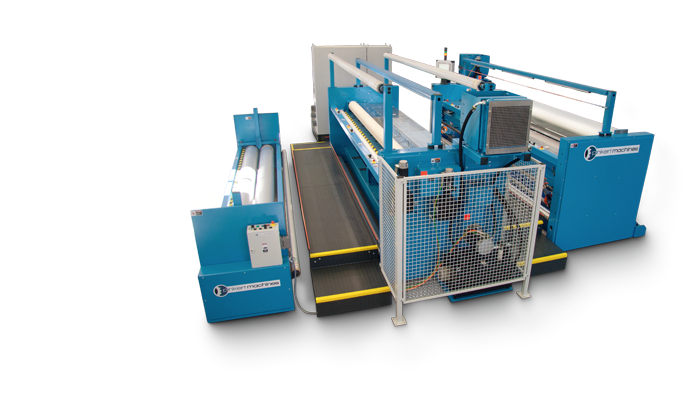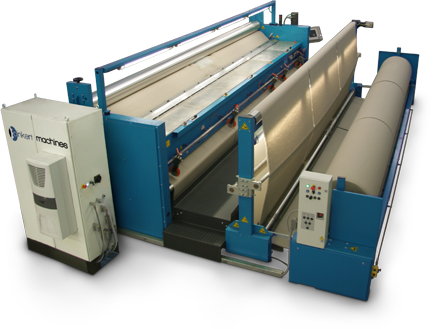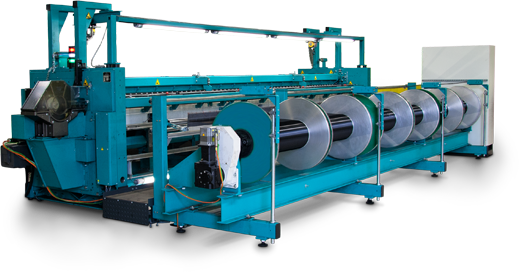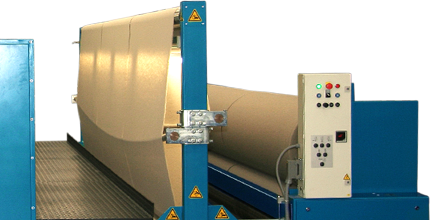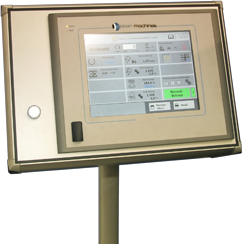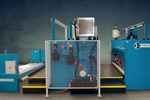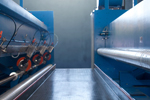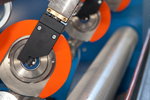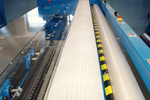KUNIT
A high-performance stitch-bonding machine for the mechanical bonding of mainly lengthwise-oriented fibrous webs by one-sided, surface stitch-formation along with simultaneous forming of pile creases with fibers arranged vertically to the fabric line.
MULTIKNIT
A high-performance stitch-bonding machine for the additional mechanical bonding of different fabric fines, especially of Kunit nonwovens by surface stitch-formation of textile fabrics with open pile structure.
Manufacturing principle and machine arrangement
ln general, the production of Kunit nonwovens is done as interconnected operation with a web-forming machine, preferably a double doffer card. For the single-layer Multikunit production we would recommend the interconnected Operation with web-forming machine and stitch-bonding machine Kunit The extended version of Multikunit technique implies at least the discontinuous feeding of one to max. three additional fabric lines (from batch or roll).
Basically, the following manufacturing principles are possible:
- Web forming machine- Kunit- fabric batcher
- Web forming machine- Kunit- Multikunit – fabric batcher
In case of external Kunit nonwoven production, the solo operation of a Multikunit stitch-bonding machine is also possible.
Products
- Kunit is a voluminous nonwoven with one-sided knit surface made of 100 % fibers, comprising a high percentage of fibers arranged vertically to the fabric line.
- Multikunit is o mechanically bonded voluminous nonwoven made of 100 % fibers, consisting of a double-sided knit surface (exterior) and of fibers arranged vertically to the fabric line (interior) (spacer nonwoven). Typical of a Multikunit composite fabric is the combination of different materials with at least one nonwoven layer, at the same time preserving the structural properties of the simple Multikunit nonwoven
Product advantages
lt is possible to process all commonly used natural and man-made fibers as well as reclaimed fibers. The production of Caliweb® articles requires the use of a certain portion of thermally activated melting and/or bi-component binder fibers.
The nonwovens as well as the composites produced with surface textiles can be completely recycled. Depending on the quality of reclaimed fibers, it is possible to use these fibers for the nonwoven production without any problem.
The Kunit/Multikunit technology offers the possibility to manufacture nonwovens with a high portion of fibers arranged nearly vertically to the fabric surface. At the same time these products have excellent moulding properties {shaping behavior].
The purposeful-interlacing of the pile face of Kunit nonwovens according to the Multikunit procedure results in reduced fiber migration, at the same time maintaining the fabric flexibility.
Compared to conventional upholstery materials, Caliweb® nonwovens are characterized by high permeability to air and water-vapour as well as good ageing behavior. Besides, it is also possible to use environmentally-acceptable laminating procedures, resulting in low emission values of the product.
Fields of applications
- Textile upholstery materials used as sub-upholstery fabrics for car seats
- Upholstery components for decorative cladding {soft-touch moulding parts) for automotive interior
- Headliners /door side-panels
- Heat and/or noise protecting linings in vehicles
- Sub-upholstery materials for leather/textile upholstered furniture
- Secondary carpet backings (with good walking properties)
- Textile filter materials
- Base materials for adhesive tapes
- Lining materials for apparel/ and shoes
- Covers for mattresses/ anti-decubitus mattings
- Medical absorbing materials
- Packaging, insulating and absorbing materials




